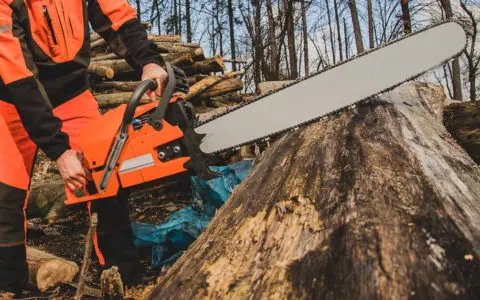When it comes to pruning or felling trees, it’s important to have the right tools for the task at hand. Depending on the job, you might require rope, climbing gear, rigging, or other arborist tools and hardware. But one thing you’ll always need is a saw.
It’s easy to look at a handsaw and a chainsaw and come to the conclusion that the chainsaw is superior. After all, it’s more powerful and does all the cutting for you.
However, experienced arborists recognize the importance of both the handsaw and the chainsaw, as well as the need for a chainsaw of the proper size.
The truth is, there are plenty of scenarios where you should reach for your handsaw instead of your chainsaw. Knowing when to use each saw will not only make you more efficient when pruning or cutting, but it will keep you safe, too.
When to Use a Handsaw
Using a heavy chainsaw for cuts that can easily be accomplished with a handsaw is unnecessary. Though handsaws come in a variety of sizes and types, they’re excellent at quickly cutting through smaller branches. This makes handsaws especially useful when it comes to pruning a tree.
If you’re pruning a tree, for example, and you see a bunch of small diameter branches that need to be removed, your handsaw should be your tool of choice. These are simple, quick cuts that don’t require much physical effort, so lugging your chainsaw from branch to branch is only going to slow you down.
Additionally, handsaws can be preferable for removing hard-to-reach branches. It’s much easier to maneuver a handsaw with one arm to get to these branches, especially when you need to reach to make the cut.
In that same vein, handsaws are more ideal for cuts you’re making above shoulder height. Lifting a chainsaw at or above head level is not only strenuous, but dangerous. If you cannot move up higher in the tree to ensure the cut is below shoulder height, stick with the handsaw.

When to Use a Chainsaw
A chainsaw is the ideal tool when it’s time to make cuts on some larger branches. As great as handsaws are, you should never find yourself huffing and puffing as you attempt to cut through a branch that’s a foot or more in diameter.
The thicker a branch is, the more valuable your chainsaw becomes. Using a chainsaw to trim these larger branches will significantly speed up the job while minimizing your exertion. As long as you make sure to avoid making cuts above shoulder height, and you keep your handsaw nearby for any hard-to-reach branches, you’ll have no issues using your chainsaw.
Although it’s easy enough to find handsaws large enough to fell trees, this is another area where chainsaws are preferred. Felling a tree is a big job; several cuts need to be made, and safety should always be a top concern. Using a chainsaw is not only faster, but it’s much less arduous, so you can stay alert and focused just in case things go sideways.
Why Chainsaw Size is Important
Chainsaws are definitely the better option when making cuts on larger branches or trunks, but it’s also important to ensure you have the right size chainsaw–and chainsaw accessories–for the job at hand. Chainsaws can be as short as 6” and go up to 20” or larger.
Before making any cuts, check to ensure your chainsaw is at least two inches longer than the diameter of the branch or tree you are cutting. This guarantees that the branch or trunk you are cutting can be completely severed with one pass of the chainsaw.
So, does that mean you should buy the largest chainsaw available to ensure it can cut branches or trees of any size? Not necessarily. Using a chainsaw that is significantly longer than the diameter of the branch being cut can also be problematic.
Larger chainsaws experience increased vibrations and are heavier, so they can be difficult to manage. Plus, kickbacks are more common with longer chainsaws. If you’re unfamiliar, a kickback is when the chain’s rotation is blocked and the chainsaw flies back toward the operator.
At the end of the day, there’s no single saw that’s perfect for all situations. It might not be feasible to have a range of saws for every occasion, but having at least one handsaw and chainsaw is always recommended for arborists or anyone who prunes or fells trees on occasion.
Having the right tool for the job is essential. If you find that you’re missing certain tools or equipment, or you’re in need of some upgrades, look no further than Rock N Rescue’s range of arborist supplies.

